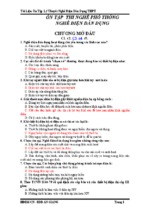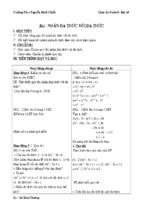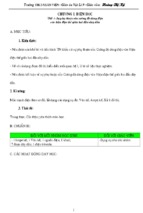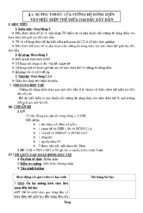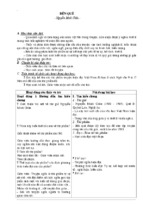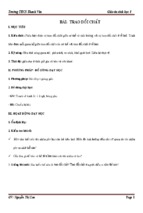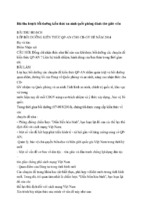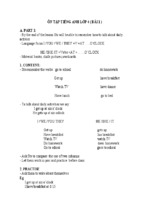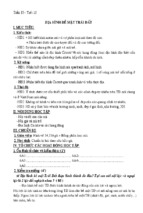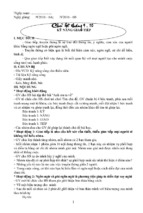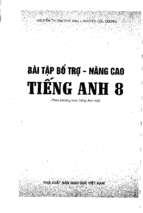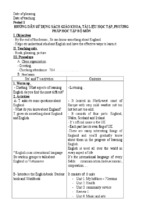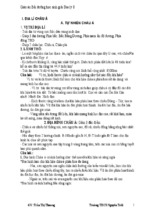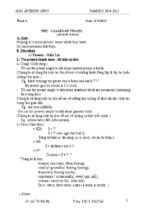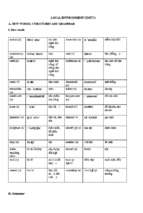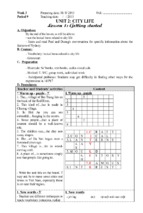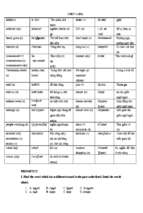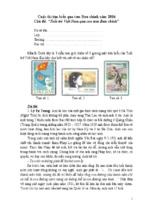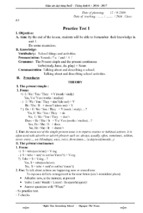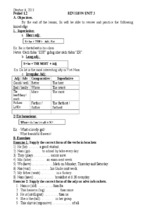Giáo án Tiếng anh 7
UNIT 13: ACTIVITIES
SECTION: A; B
Periods
Objectives
Language contents
* Grammar:
1
- Describe sporting activities.
A1, A3
Adjectives and adverbs.
* Vocabulary:
Words relating to sport
(review)
2
A4, A5
Give advice about sporting
activities for owner.
Techniques
Listening reading
Questions –
answers
Role play
* Grammar:
Reading
Adjectives and adverbs
(review)
Questions –
answers
* Vocabulary:
Gap – filling
Words relating to sport.
3
B1
* Grammar:
Make an invitation
Listening
Review modal verbs
Role play
Modal verb: ought to
Questions –
answers
* Vocabulary:
Paddles …
4
* Grammar:
Listening role
B2
Refuse an invitation
Review modal verbs
Play gap filling
+ Come and play basketball
+ I’m sorry. I don’t think I
can
* Vocabulary:
Review
5
B3
Explore in the Oceans
* Grammar: review
Reading
* Vocabulary: words relating
to equipment about swimming
Questions –
answers.
UNIT 13: ACTIVITIES
Section: A1 + A3
Period 1
A. SPORTS
I. OBJECTIVE:
- Students learn how to describe sporting activities.
II. LANGUAGE CONTENS:
* Grammar: Adverbs and adjectives.
* Vocabulary:
* Noun: Baseball, skateboarding, Roller – skating …………..
* Adjectives: Slam dunked, popular, skillful, and safe.
III. TECHNIQUES:
- Role play.
- Questions - Answers.
IV. TEACHING AIDS:
- Pictures and cassettes.
V. TIME: 45 minutes
VI. PROCEDURES:
Sections
Steps
A1+A3
Warm up
Techniques and contents
Introduces the topic:
Asks students which sports are their favorite
Drawing
experience
ones and in their free time which one they
often play.
10’
Skill
developing
Practice
Controlled
A1
Let them look at the pictures indicating
sports.
Asks whether some of them play any the
sports in the pictures.
Tell them the content of the reading they are
going to listening and read.
Students listen to the teacher carefully
before listening and reading.
Names 10 sports which are the most popular
that they young in America love to play.
Students try to remember as many sports as
possible, then retell them.
Let students listen the cassette twice.
Student listens to the cassette attentively.
Asks them: read by them.
Student read careful
Call some students and asks them to tell the
names of some sports lists.
Sports: Baseball, skate-boarding, rollerskating, roller-balding, basketball, football,
tennis, badminton, swimming.
Have some of students to do some actions
illustrating some sports to attract their
attention more, then asks other to guess
what they are.
Students try to guess which sports are
illustrating and give correct answers.
Let them practice in pairs, asking and
answering the questions given.
Call some pairs to drill before class, corrects
if there is mistakes. Students do as
requested.
A3 listen
then practice
with a
partner.
Asks students to look at the pictures,
observe and then tell what people in the
pictures do.
Students look at the pictures and do as
requested.
Let students listen to the cassette twice.
Asks questions – answers
What’s he? He’s a soccer player
Is he a good soccer? Yes, he is.
What does he play? He plays soccer well.
Use substitution drill and let students work
on other pictures.
Students do as requested.
Have students practice in pairs
Teacher writes 6 pairs of sentences on the
board and calls some students to underline
the adjectives and adverbs in these
sentences.
Students look at the board and find out the
adjectives adverbs then underline them.
Tell students the difference between
adjectives and adverbs and their usage.
Give them some more adjectives and
adverbs, then asks them to write some more
sentences, using the adjectives and adverbs
given.
Let students take notes.
Notes
Adjectives Adverbs
Dangerous dangerously
Skillful
Consolidation
skillfully
Slow
slowly
Bad
badly
Quick
quickly
Safe
safely
Sudden
suddenly
Adjective + ly = adverb of manner
Irregular adjective:
7’
3’
Good – well
Ex: He a good soccer player
He plays well
Adverb
Adjective qualify nouns
Adverb modifies verbs.
Ex: He a skillful volleyball player
He plays skillfully
She a slow swimmer
She swims slowly
Homework: Write the adverbs corresponding to
the adjectives
Ex: Good –well (A1, A2, A3, P.82)
And complete the sentence use adjectives,
adverbs in bracket.
Ex: My brother cycles slowly. She is a slow
cyclist (slow/slowly)
UNIT 13: ACTIVITIES
Period 2 (A4 + A5)
A. SPORTS
I. OBJECTIVE:
- Students learn how to give advice about sporting activities for owner.
II. LANGUAGE CONTENS:
* Grammar: Adverbs and adjectives (review).
* Vocabulary: words relating to sport.
III. TECHNIQUES:
- Role play.
- Questions – Answers.
- Gap - filling.
IV. TEACHING AIDS:
- Pictures and cassettes.
V. TIME: 45 minutes
VI. PROCEDURES:
Sections
Steps
A4
Read then
answer the
questions
Techniques and contents
Show students a picture of badminton.
Students look at the pictures and observe.
Asks them whether they know.
Or play this sport and what to play
badminton.
Students answer and tell to the teacher
Drawing
experience
about badminton. Show students “Rackets,
Shut-tecock, net”.
Let students read the text carefully.
Explains clearly the meaning of the word
“single” “double” and tell them how to use
them.
Let them answer the question given.
Question – answers: students identify
answer keys.
Answer keys.
a) People need a pairs of rackets, a
shuttlecock, a net, and a small piece of land
to play badminton.
b) The player hit the shuttlecock over the net
with their rackets.
c) The two kind of badmintons game.
Are the games of singles and the game of
doubles.
d) Some players wear a band over their wrist
to play the games safely.
e) Indonesia is the country which often wins
the badminton World Cup, China and Korea
sometimes win the world Cup, too.
Let them take some note about the
championship of badminton.
A5
Show students a picture to guess the sports
activities relating to the pictures.
Let students discuss the place which
students swim.
Students read all the posters and do
exercises.
Teacher calls some students to check, give
the keys and correct their mistakes.
Teacher explain some new words in
Vietnamese quickly.
New words: lifeguard, poor edge, yellow
flags.
Homework: A4 p.83
Write true sentences about how you do these things.
Example: I run quickly.
UNIT 13: ACTIVITIES
Period 3 – B1
B. COME AND PLAN
I. OBJECTIVE:
- Students learn how to make an invitation.
II. LANGUAGE CONTENS:
* Grammar: Review modal verbs: Ought to.
* Vocabulary: Paddles (words relating to sport).
III. TECHNIQUES:
- Listening
- Role play
- Questions – Answers
IV. TEACHING AIDS:
- Pictures and cassettes.
V. TIME: 45 minutes
VI. PROCEDURES:
Sections
Steps
B1
Warm up
Techniques and contents
Introduces the topic.
Let students look at the pictures and asks
what Ba and Nam doing, then introduce the
situation.
Students observe the pictures and answer
the question and listen to the introduction.
Drawing
experience
Let them listen to the cassette twice, and
then have them repeat.
Calls some pairs play the role before class
about Nam and Ba.
Pairs work: practice with partner.
Asks them to pick out the modal verbs an
and give the information of three forms as
quickly as possible.
Students ask – answer the question (using
the idea given in the dialogue).
Students take notes.
Modal verbs: Can, must, have to, ought to,
might…
Affirmative: S + might / can/must/should/
have to/ has to/ ought to + v (bare inf)
Negative:
S + mightn’t/ can’t/ shouldn’t/ mustn’t
oughtn’t to/ don’t have to/ doesn’t have to + v
* Interrogative:
Can
Must
+ s + (bare inf)?
Should
Ought + S + to + v (bare inf)?
Do / does + s + have to + v (bare infi).
Homework: do exercise B – Come and play
B1 invite your friend to the activities. Use would you like to/ come and
Example: Chess
Would you like to play chess with me, Minh?
Come and play chess with me, Minh.
UNIT 13: ACTIVITIES
Period 4
B. COME AND PLAN
I. OBJECTIVE:
- Students learn how to refuse an invitation.
II. LANGUAGE CONTENS:
* Grammar: Review modal verbs.
* Come and play basketball.
* I’m sorry. I don’t think I can.
* Vocabulary: Review
III. TECHNIQUES:
- Listening
- Role play
- Questions – Answers
- Gap - filling
IV. TEACHING AIDS:
- Pictures and cassettes.
V. TIME: 45 minutes
VI. PROCEDURES:
Sections
Steps
B2
Practice
Techniques and contents
Let students listen to the cassette twice.
Drawing
experience
Skill
development
(listening)
Controlled
Tell them to replace the underlined words
by the cues given to make other dialogues.
Teacher give example a).
Pairs work: practice their own dialogue
before the class.
Ask and answer by using the modal verbs to
write the invitation.
Corrects their mistakes if there is.
Students do as requested.
Fill in the blanks what you heard.
Consolidation
Home work: Invite your friend to the
activities.
Pre-listening Would you like to chess with me>
While
Come and play chess with me, Minh.
listening
Homework: Do exercise in B2 – page 84 – Workbook; prepare B3, complete the dialogues.
UNIT 13: ACTIVITIES
Period 5 (B3)
B. COME AND PLAN
I. OBJECTIVE:
- Students learn how to explore in the oceans.
II. LANGUAGE CONTENS:
* Grammar: Review
* Vocabulary: words relating to equipment about swimming.
III. TECHNIQUES:
- Reading
- Role play
- Questions – Answers
IV. TEACHING AIDS:
- Pictures and cassettes.
V. TIME: 45 minutes
VI. PROCEDURES:
Sections
Steps
B3
Warm up
Techniques and contents
Let students observe a picture and guess
what it is.
Students look at the picture and make a
guess.
Asks some questions to elicit the meaning
of the words: scuba-diving, pearl diver
Drawing
experience
invention, special bread thing equipment,
(with the help of the picture) vessel, explore
deep sea.
Consolidation
Students listen and answer, notice the
meanings of the words given.
Teacher read over the text and request them
to follow attentively.
Students read carefully.
If we are not sure that our students can
understand all the text, ask them to
translation.
Students read sentence by sentence and do
the translation.
Questions – answers: students identify their
choice true or false.
Teacher checks the answers and corrects if
there is mistakes.
Tell them something more about Jacques
Cousteau (1910-1997).
Questions – answers.
Homework: Complete the dialogues. Use can
or must. In the workbook (B3/p85)
- Xem thêm -

